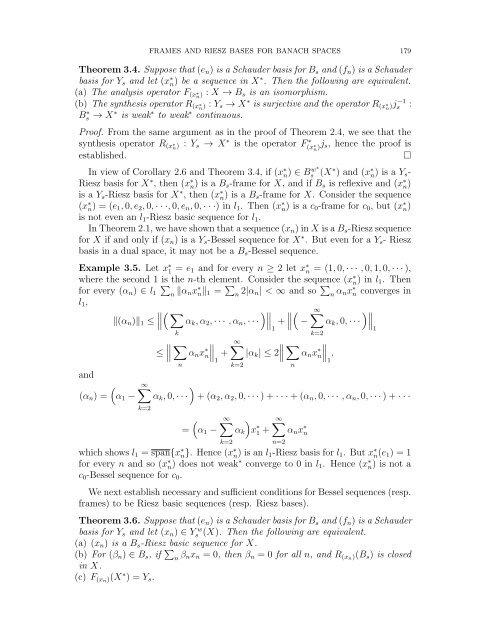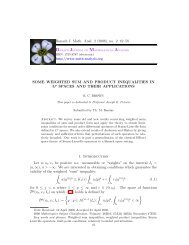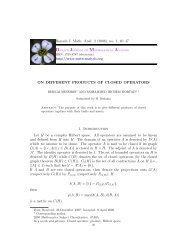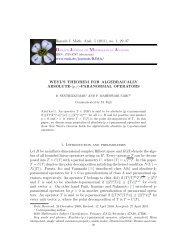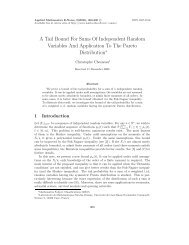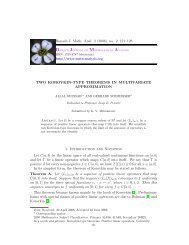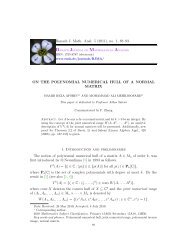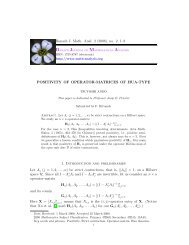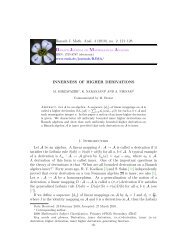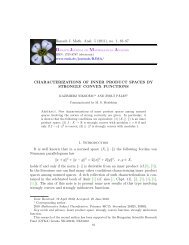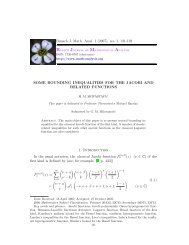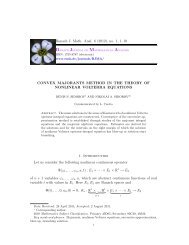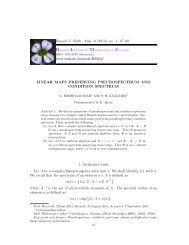Frames and Riesz bases for Banach spaces, and Banach spaces of ...
Frames and Riesz bases for Banach spaces, and Banach spaces of ...
Frames and Riesz bases for Banach spaces, and Banach spaces of ...
- No tags were found...
Create successful ePaper yourself
Turn your PDF publications into a flip-book with our unique Google optimized e-Paper software.
FRAMES AND RIESZ BASES FOR BANACH SPACES 179Theorem 3.4. Suppose that (e n ) is a Schauder basis <strong>for</strong> B s <strong>and</strong> (f n ) is a Schauderbasis <strong>for</strong> Y s <strong>and</strong> let (x ∗ n) be a sequence in X ∗ . Then the following are equivalent.(a) The analysis operator F (x ∗ n ) : X → B s is an isomorphism.(b) The synthesis operator R (x ∗ n ) : Y s → X ∗ is surjective <strong>and</strong> the operator R (x ∗ n )js −1 :Bs ∗ → X ∗ is weak ∗ to weak ∗ continuous.Pro<strong>of</strong>. From the same argument as in the pro<strong>of</strong> <strong>of</strong> Theorem 2.4, we see that thesynthesis operator R (x ∗ n ) : Y s → X ∗ is the operator F(x ∗ ∗ )j s, hence the pro<strong>of</strong> isnestablished.□In view <strong>of</strong> Corollary 2.6 <strong>and</strong> Theorem 3.4, if (x ∗ n) ∈ B w∗s (X ∗ ) <strong>and</strong> (x ∗ n) is a Y s -<strong>Riesz</strong> basis <strong>for</strong> X ∗ , then (x ∗ n) is a B s -frame <strong>for</strong> X, <strong>and</strong> if B s is reflexive <strong>and</strong> (x ∗ n)is a Y s -<strong>Riesz</strong> basis <strong>for</strong> X ∗ , then (x ∗ n) is a B s -frame <strong>for</strong> X. Consider the sequence(x ∗ n) = (e 1 , 0, e 2 , 0, · · ·, 0, e n , 0, · · ·) in l 1 . Then (x ∗ n) is a c 0 -frame <strong>for</strong> c 0 , but (x ∗ n)is not even an l 1 -<strong>Riesz</strong> basic sequence <strong>for</strong> l 1 .In Theorem 2.1, we have shown that a sequence (x n ) in X is a B s -<strong>Riesz</strong> sequence<strong>for</strong> X if <strong>and</strong> only if (x n ) is a Y s -Bessel sequence <strong>for</strong> X ∗ . But even <strong>for</strong> a Y s - <strong>Riesz</strong>basis in a dual space, it may not be a B s -Bessel sequence.Example 3.5. Let x ∗ 1 = e 1 <strong>and</strong> <strong>for</strong> every n ≥ 2 let x ∗ n = (1, 0, · · · , 0, 1, 0, · · · ),where the second 1 is the n-th element. Consider the sequence (x ∗ n) in l 1 . Then<strong>for</strong> every (α n ) ∈ l 1∑n ‖α nx ∗ n‖ 1 = ∑ n 2|α n| < ∞ <strong>and</strong> so ∑ n α nx ∗ n converges inl 1 ,( ‖(α n )‖ 1 ≤∑)∥ ( ∥∥1 ∞∑ )∥ ∥∥1∥ α k , α 2 , · · · , α n , · · · + ∥ − α k , 0, · · ·<strong>and</strong>(α n ) =(α 1 −∞∑k=2≤k∥ ∑ nα n x ∗ n∥ +1∞∑|α k | ≤ 2∥ ∑ nk=2k=2α n x ∗ n∥ ,1)α k , 0, · · · + (α 2 , α 2 , 0, · · · ) + · · · + (α n , 0, · · · , α n , 0, · · · ) + · · ·=(α 1 −∞∑α k)x ∗ 1 +k=2∞∑α n x ∗ nwhich shows l 1 = span{x ∗ n}. Hence (x ∗ n) is an l 1 -<strong>Riesz</strong> basis <strong>for</strong> l 1 . But x ∗ n(e 1 ) = 1<strong>for</strong> every n <strong>and</strong> so (x ∗ n) does not weak ∗ converge to 0 in l 1 . Hence (x ∗ n) is not ac 0 -Bessel sequence <strong>for</strong> c 0 .We next establish necessary <strong>and</strong> sufficient conditions <strong>for</strong> Bessel sequences (resp.frames) to be <strong>Riesz</strong> basic sequences (resp. <strong>Riesz</strong> <strong>bases</strong>).Theorem 3.6. Suppose that (e n ) is a Schauder basis <strong>for</strong> B s <strong>and</strong> (f n ) is a Schauderbasis <strong>for</strong> Y s <strong>and</strong> let (x n ) ∈ Ys w (X). Then the following are equivalent.(a) (x n ) is a B s -<strong>Riesz</strong> basic sequence <strong>for</strong> X.(b) For (β n ) ∈ B s , if ∑ n β nx n = 0, then β n = 0 <strong>for</strong> all n, <strong>and</strong> R (xn)(B s ) is closedin X.(c) F (xn)(X ∗ ) = Y s .n=2


